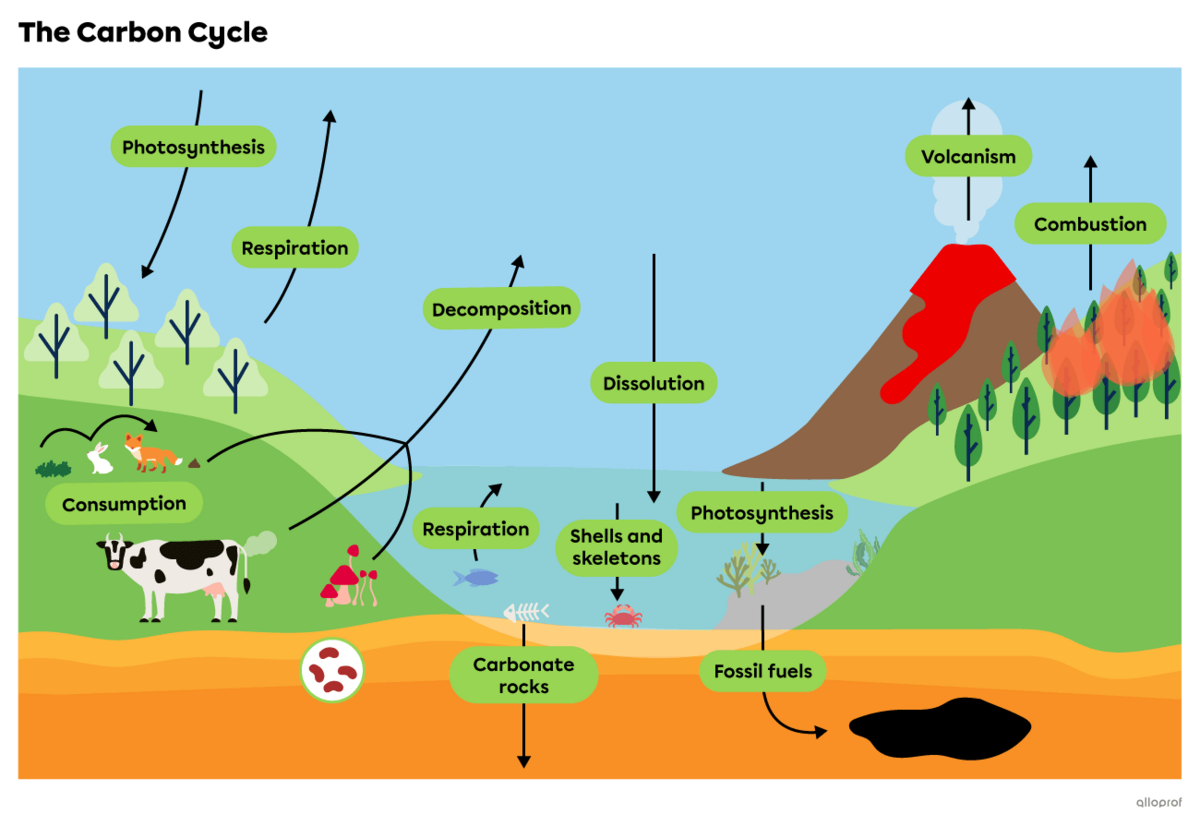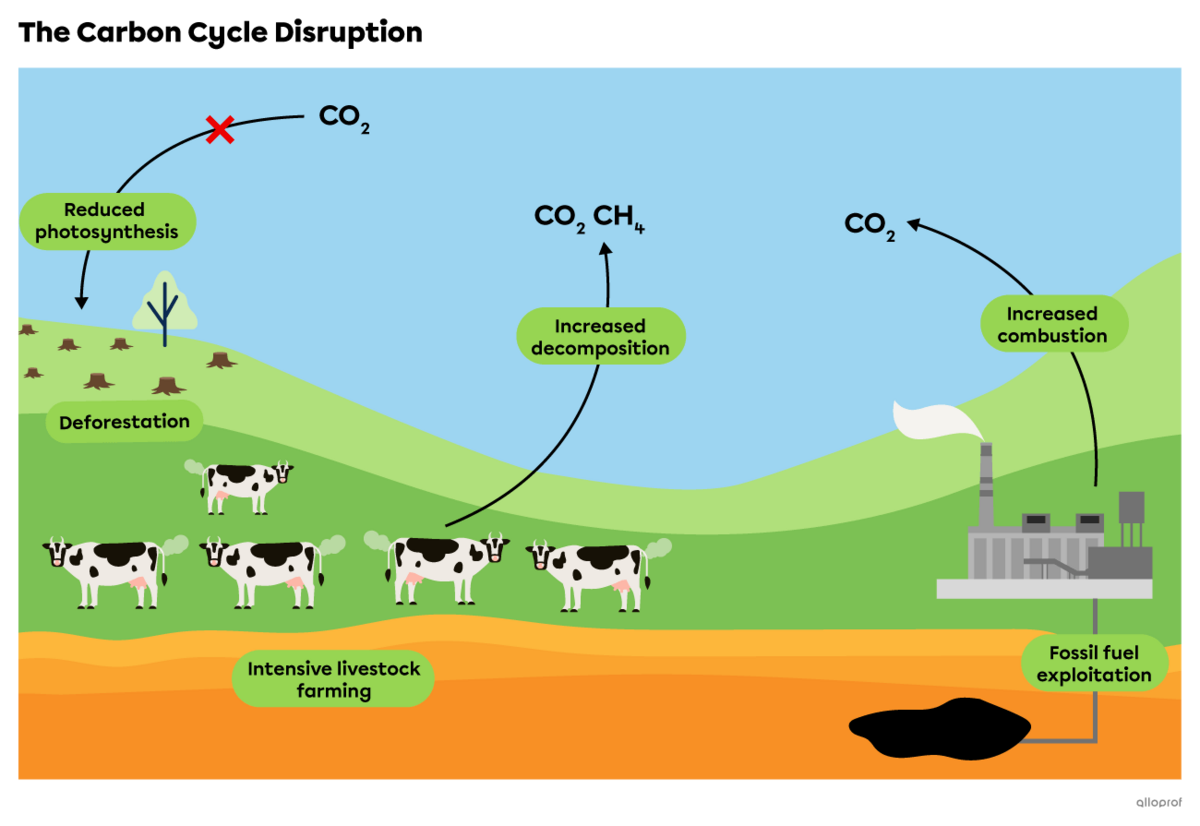Carbon |\text{(C)}| is a chemical element that’s essential for life. The amount of carbon on Earth is constant.
Carbon is constantly being recycled and made available to living organisms via a biogeochemical cycle: the carbon cycle.
The carbon cycle makes up all the transformations that carbon undergoes naturally to move around the atmosphere, the biosphere, the hydrosphere, and the lithosphere.

This diagram shows the processes that make up the carbon cycle. For more information on each of these transformations, consult the following table.
|
Transformation |
Carbon exchange and its description |
|---|---|
|
Atmosphere → Biosphere Terrestrial plants capture carbon dioxide |(\text{CO}_2)| from the atmosphere and convert it into glucose |(\text{C}_6\text{H}_12\text{O}_6).| |
|
|
Hydrosphere → Biosphere Aquatic plants capture the |\text{CO}_2| dissolved in the water and transform it into |\text{C}_6\text{H}_12\text{O}_6.| |
|
|
Consumption |
Biosphere → Biosphere Animals feed on plants and/or other animals. The ingested carbohydrates, proteins, and lipids are rich in carbon. These molecules are essential for cell growth, repair and proper functioning. |
|
Biosphere → Atmosphere Living organisms use |\text{C}_6\text{H}_12\text{O}_6| and produce |\text{CO}_2| through cellular respiration. |
|
|
Decomposition |
Biosphere → Atmosphere Decomposers (e.g., fungi) break down the waste and corpses of dead organisms. This transformation produces |\text{CO}_2| and methane |(\text{CH}_4).| |
|
Formation of fossil fuels |
Biosphere → Lithosphere The waste and corpses of dead organisms buried underground can, after several million years, be transformed into fossil fuels like oil, coal, and natural gas. These substances are rich in carbon. |
|
Biosphere → Atmosphere The combustion of organic matter by forest fires produces |\text{CO}_2.| |
|
|
Dissolution |
Atmosphere → Hydrosphere Atmospheric |\text{CO}_2| dissolves in water to form carbonate |(\text{CO}_3^{2-})| and bicarbonate |(\text{HCO}_3^-)| ions. |
|
Formation of shells and skeletons |
Hydrosphere → Biosphere In water, the |\text{CO}_3^{2-}| and |\text{HCO}_3^-| ions react with calcium |\text{Ca}| to form calcium carbonate |(\text{CaCO}_3).|. This salt is a constituent of the shells and skeletons of aquatic animals. |
|
Carbonate rocks formation |
Biosphere → Lithosphere Shells and skeletons rich in |\text{CaCO}_3| are deposited on the ocean floor, forming carbonate rocks. |
|
Volcanism |
Lithosphere → Atmosphere When molten carbonate rocks come into contact with magma, they release |\text{CO}_2.| |
Fossil fuel exploitation, deforestation and intensive livestock farming are human activities that disrupt the carbon cycle.
They increase the amount of carbon dioxide |(\text{CO}_2)| and methane |(\text{CH}_4),|, two greenhouse gases (GHGs), in the atmosphere. This increases the enhanced greenhouse effect, which in turn has several consequences.

The exploitation of fossil fuels disrupts the carbon cycle by increasing the flow of carbon from the lithosphere to the atmosphere. The combustion of oil, coal and natural gas increases the amount of |\text{CO}_2| in the atmosphere.
The following table shows the main uses of fossil fuels.
|
Resources |
|||
|---|---|---|---|
|
Main use |
Transportation |
Power generation |
Heating |
Deforestation disrupts the carbon cycle by reducing the flow of carbon from the atmosphere to the biosphere. Since felled trees no longer contribute to photosynthesis, a greater quantity of |\text{CO}_2| remains in the atmosphere.
Intensive livestock farming disrupts the carbon cycle by increasing the flow of carbon from the biosphere to the atmosphere. The decomposition of organic waste from livestock increases the amount of |\text{CO}_2| and |\text{CH}_4| in the atmosphere.